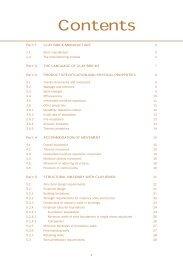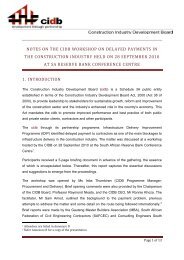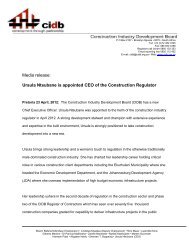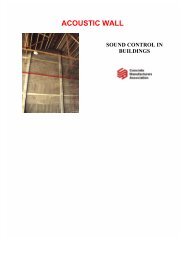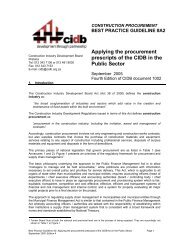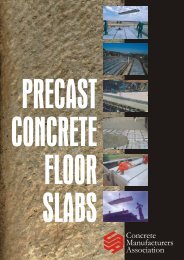MANUAL 4 - Construction Industry Development Board
MANUAL 4 - Construction Industry Development Board
MANUAL 4 - Construction Industry Development Board
Create successful ePaper yourself
Turn your PDF publications into a flip-book with our unique Google optimized e-Paper software.
MODULE<br />
1<br />
2<br />
3<br />
4<br />
5<br />
6<br />
7<br />
<strong>MANUAL</strong> 4 – BITUMINOUS PAVEMENT SEALS<br />
Fines content<br />
The amount of fines (< 0,075 mm) should preferably not exceed 10%. A higher fines content<br />
may result in construction problems, as the binder tends to coat the finer particles before the<br />
larger ones. This may lead to a less durable surfacing with inferior surfacing characteristics.<br />
However, aggregate with fines contents up to 15% have performed well on one project in<br />
Botswana, and no surfacing defects have yet been recorded, due to excessive fines contents<br />
on any project in the country.<br />
Flakiness<br />
No requirement for flakiness is specified for natural gravel or as mixture of crushed and<br />
natural gravel in Otta seals. For crushed rock, it is preferable that the weighted flakiness<br />
index does not exceed 30. The weighted flakiness index is determined on the following<br />
fractions:<br />
Sand-cover seals<br />
9,5 – 13,2 mm 6,7 – 9,5 mm 4,74 – 6,7 mm<br />
Material for a sand-cover seal used in Otta seals can be crusher dust, river sand, Kalahari<br />
sand or a combination of these materials. The material should be free from organic matter<br />
and lumps of clay, and should be non-plastic. All material should preferably pass the 6,7 mm<br />
sieve.<br />
5.2.5 Preferred aggregate grading<br />
The design of Otta seals allows for a variety of aggregate gradings to be used, as long as the<br />
grading curve falls within the designated area of the general grading envelope and runs as<br />
smoothly and parallel to the envelope as possible.<br />
As guidance for the designer of Otta seals, three grading envelopes, depending on traffic,<br />
have been produced to allow for a more rational design. However, the designer should always<br />
bear in mind that all types of aggregate which fall within the general specified envelope can<br />
be used, provided the binder viscosity and spray rates are tailored accordingly.<br />
The only limitation, regarding the aggregate grading used in an Otta seal, is the open<br />
grading which should not be used for traffic volumes above AADT 1 000.<br />
Table 4.12 indicates the preferred aggregate grading for design purposes, according to<br />
traffic volume.<br />
AADT Best Suited Grading<br />
Less than 100<br />
100 – 1 000<br />
More than 1 000<br />
Open<br />
Medium<br />
Dense<br />
Table 4.12: Preferred aggregate grading for Otta seals<br />
The grading envelopes for open, medium and dense grading are given in Table 4.13 the<br />
design procedure for Otta seals.<br />
IMPLEMENTING EMPLOYMENT INTENSIVE ROAD WORKS 84





